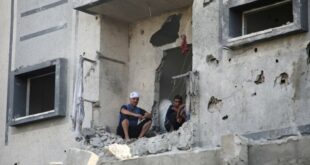Successful launch of Simorgh rocket comes after multiple failures in the past

Iran's government said Sunday it successfully launched three satellites into space with a rocket that had multiple failures in the past, the latest for a program that the West says improves Tehran's ballistic missiles.
The launch comes as heightened tensions grip the wider Middle East over Israel's continued war on Hamas in the Gaza Strip, sparking fears of a regional conflict.
While Iran has not intervened militarily in the conflict, it has faced increased pressure within its theocracy for action after a deadly Islamic State suicide bombing earlier this month and as proxy groups like Yemen's Houthi rebels conduct attacks linked to the war.
Meanwhile, Western nations remain worried about Iran's rapidly expanding nuclear program.
Footage released by Iranian state television showed a nighttime launch for the Simorgh rocket. An Associated Press analysis of the footage showed that it took place at the Imam Khomeini Spaceport in Iran's rural Semnan province.
"The roar of the Simorgh (rocket) resonated in our country's sky and infinite space," said Abbas Rasooli, a state TV reporter, in the footage.
State TV named the launched satellites Mahda, Kayhan-2 and Hatef-1. It described the Mahda as a research satellite, while the Kayhan and the Hatef were nanosatellites focused on global positioning and communication respectively.
Iran's Information and Communications Technology Minister Isa Zarepour said the Mahda had already sent signals back to Earth.
There have been five failed launches in a row for the Simorgh program, another satellite-carrying rocket. The Simorgh, or "Phoenix," rocket failures have been part of a series of setbacks in recent years for Iran's civilian space program, including fatal fires and a launch pad rocket explosion that drew the attention of former U.S. President Donald Trump.

Iran fires missiles into northern Iraq killing 4
13 days ago
Iran's Revolutionary Guards fired missiles at what it claimed was an 'Israeli spy base' near the U.S. Consulate in the northern Iraqi city of Erbil, killing four civilians and injuring six others.
Missile program sanctions expired
The footage showed the rocket launched Sunday bore the slogan "We Can" in Farsi, likely referring to the previous failures.
The Simorgh is a two-stage, liquid-fuelled rocket the Iranians described as being designed to place satellites into a low Earth orbit.
However, the U.S. intelligence community's 2023 worldwide threat assessment said the development of satellite launch vehicles "shortens the timeline" for Iran to develop an intercontinental ballistic missile because it uses similar technology.
That report specifically cites the Simorgh as a possible dual-use rocket.
The United States has previously said Iran's satellite launches defy a UN Security Council resolution and called on Tehran to undertake no activity involving ballistic missiles capable of delivering nuclear weapons.
UN sanctions related to Iran's ballistic missile program expired last October.

Under Iran's relatively moderate former President Hassan Rouhani, the Islamic Republic slowed its space program for fear of raising tensions with the West.
However, in the time since, the 2015 nuclear deal Rouhani shepherded with world powers has collapsed and tensions have been boiling for years with the U.S. Hard-line President Ebrahim Raisi, a protégé of Supreme Leader Ayatollah Ali Khamenei who came to power in 2021, has pushed the program forward.
Meanwhile, Iran enriches uranium closer than ever to weapons-grade levels and enough material for several atomic bombs, though U.S. intelligence agencies and others assess Tehran has not begun actively seeking a nuclear weapon.
On Friday, France, Germany and the United Kingdom condemned an Iranian satellite launch on Jan. 20, similarly calling it capable of helping Iran develop long-range ballistic missiles.
"We have longstanding concerns over Iran's activity related to ballistic missile technologies that are capable of delivering nuclear weapons," the countries said.
"These concerns are reinforced by Iran's continued nuclear escalation beyond all credible civilian justification."
Tehran maintains the largest arsenal of ballistic missiles in the Mideast, in part due to decades of sanctions following its 1979 Islamic Revolution and the U.S. Embassy hostage crisis blocking it from advanced fighter jets and other weapon systems.
The U.S. military and the State Department did not immediately respond to requests for comment Sunday.
However, the U.S. military has quietly acknowledged the Jan. 20 launch conducted by the country's paramilitary Revolutionary Guard was successful.

Iran’s Axis of Resistance and its role in the Israel-Hamas war
3 months ago
Sitting on the edges of the Israel-Hamas war is what's been called the Axis of Resistance, a loose coalition of Iran-backed entities, including Hezbollah, Hamas and the Houthis in Yemen. CBC chief correspondent Adrienne Arsenault breaks down the conditions that could cause the group to engage in a wider war and the firepower behind it.
*****
Credit belongs to : www.cbc.ca
 MaharlikaNews | Canada Leading Online Filipino Newspaper Portal The No. 1 most engaged information website for Filipino – Canadian in Canada. MaharlikaNews.com received almost a quarter a million visitors in 2020.
MaharlikaNews | Canada Leading Online Filipino Newspaper Portal The No. 1 most engaged information website for Filipino – Canadian in Canada. MaharlikaNews.com received almost a quarter a million visitors in 2020.







